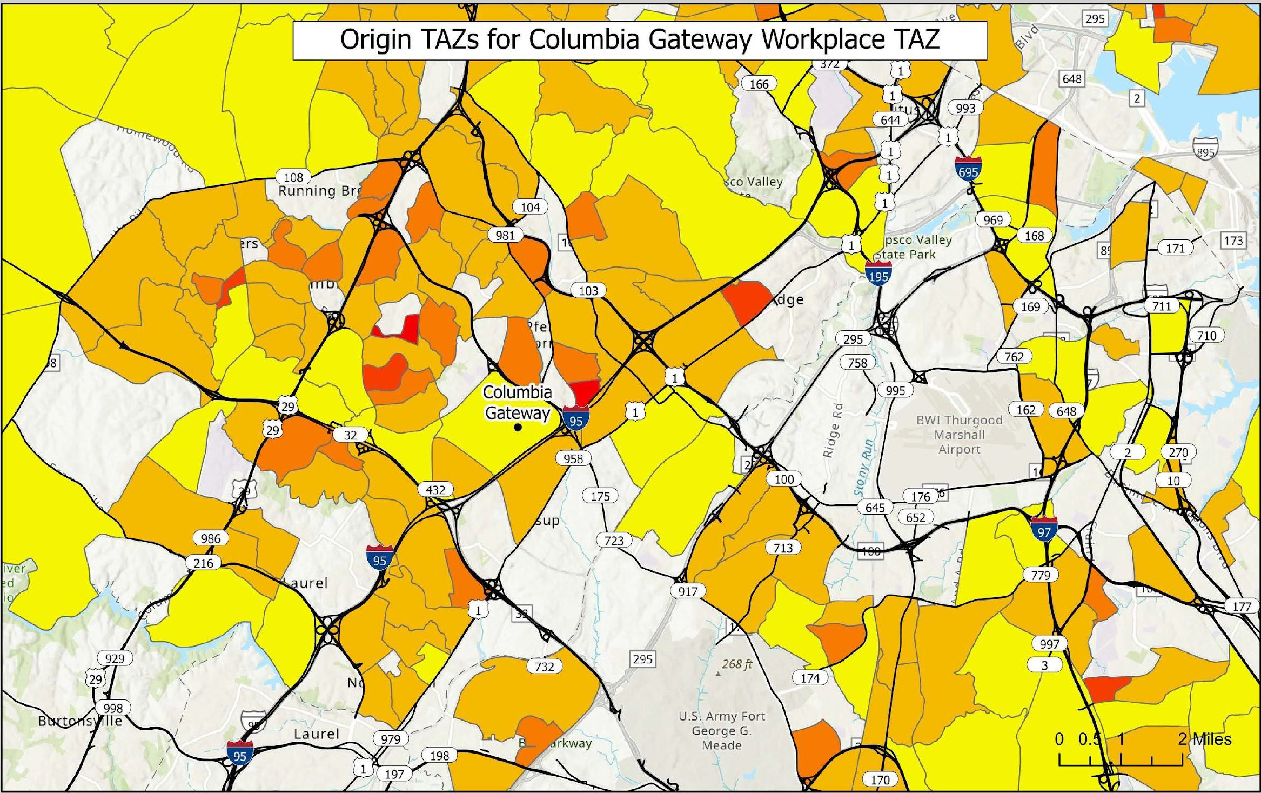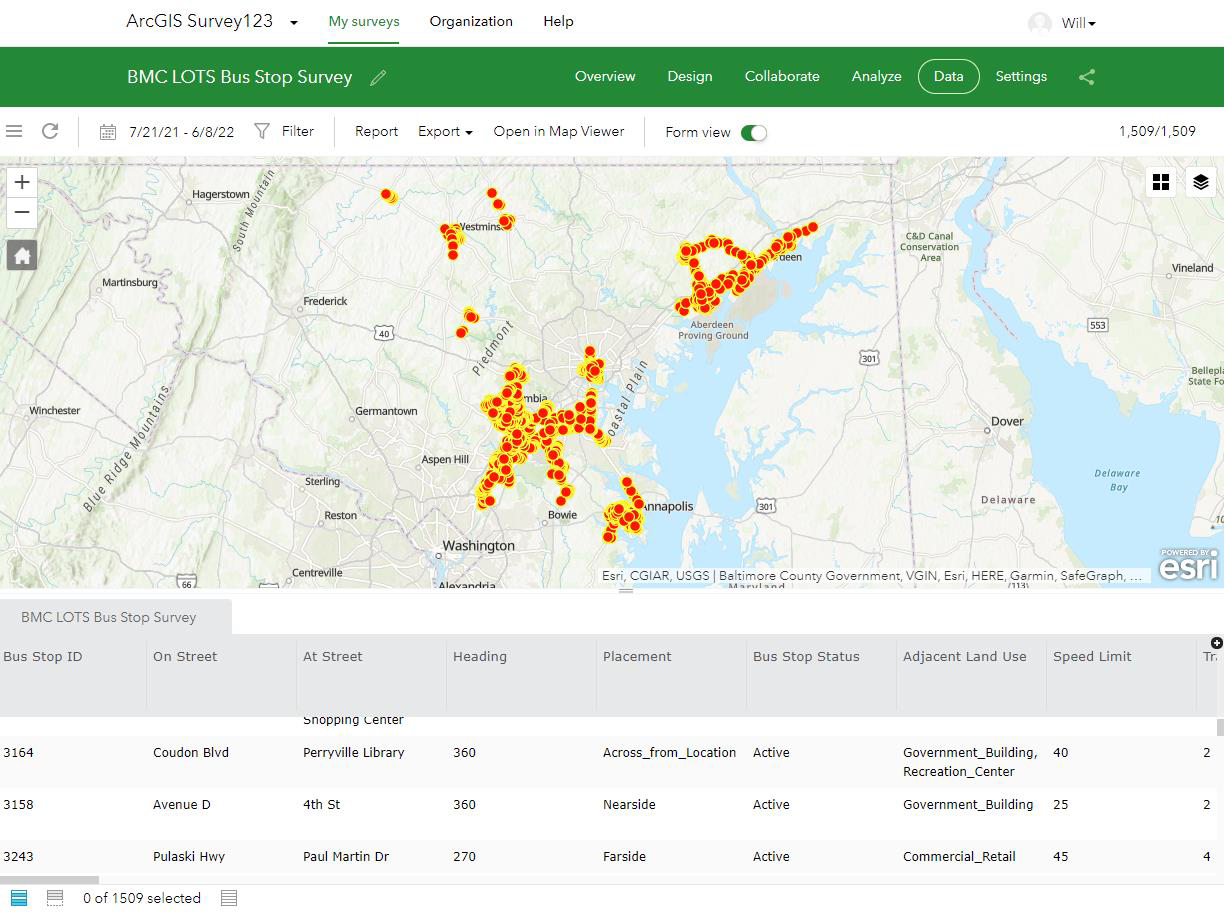Transit systems in the Baltimore region include buses, trains, ferries, light rail transit, bus rapid transit, paratransit, and metro services. Together, they play an important role in providing accessibility while also alleviating congestion and improving air quality, and promoting land use and development goals.
BRTB membership includes transit operators, with BMC staff helping to facilitate coordination between state and local service providers, brings a regional perspective to agencies when they update their Transit Development Plans and assists with planning activities. BMC staff also provides demographic data, travel demand modeling and overall analysis to the MDOT Maryland Transit Administration (MDOT MTA) and Locally Operated Transit Services (LOTS) to help improve the efficiency and effectiveness of current systems.
Recent Transit Planning Activities:
Microtransit Solutions
Microtransit is a transit service that typically uses shuttles or vans to provide on-demand service to riders through a website or smartphone application. Microtransit service provides the opportunity to connect residents and communities by offering a transit service that can be flexible to the changing demand of an area.
The Microtransit Solutions project developed best practices for implementing, operating, promoting, and funding microtransit in the Baltimore region, including the following products:
- The Microtransit Context Report summarizes existing microtransit services in the Baltimore region.
- The Enhancement Opportunities Report identifies areas in the region where microtransit is likely to be successful, along with use cases for each.
- The Peer Case Studies Report gathers insights and lessons learned from 12 peer agencies operating microtransit.
- The Microtransit Guidebook for the Baltimore Region combines the analysis and case study research into a guidebook focused on key questions facing local jurisdictions and transit operators like:
- Is microtransit the “right” service?
- How does my agency select and design a service area?
- How does microtransit integrate with other modes?
- How can residents learn how to use the service?
- How should an agency structure a clear procurement?
LOTS Training
As part of the “Transit at the Table” approach to regional planning, BRTB members agreed to support training needs and support technology advancements. Over the last year, the BRTB has collaborated with the Transportation Association of Maryland to provide skills training to Locally Operated Transit Systems and MDOT MTA. The BMC created a training authorization template that focused on trainer qualifications, length of session and cost, procurement process, and addressing FTA Circular 8100.1D Eligibility.
Below is a cross section of the training provided, grouped by working with riders, safety and security, as well as building management skills.
|
Customer Driven Service |
Conflict De-escalation |
|
Leadership Workshop - Understanding the Value of Your Employees |
|
Corridor #25 BWI to Columbia Pilot Feasibility Study (2022)
Connecting Our Future, A Regional Transit Plan for Central Maryland (MDOT MTA, October 2020) identifies 30 regional transit priority corridors. Each of these corridors contain varying levels of existing transit infrastructure. Service and demand were categorized into one of three types of opportunities for transit implementation or improvement in the plan: early, mid-term and late-term.
The plan did not define specific routes, service patterns, alignments, levels of service, potential stations or transit mode of travel. Therefore the plan calls for further refinement of the regional priority corridors through implementation of feasibility studies. BMC staff is supporting this work by conducting such feasibility studies.
The first of what is anticipated to be a series of studies, this pilot evaluated existing transit service, demographic characteristics, and land use from Baltimore/Washington International Thurgood Marshall Airport (BWI) to Downtown Columbia. The team was guided by a steering committee that included MDOT MTA, Anne Arundel and Howard Counties, and a stakeholder group representing major employers, economic development and nonprofit organizations throughout the study area.
The team developed 14 alternatives, each with multiple routing options connecting activity centers throughout the corridor. Each alternative was evaluated using criteria that included service to vulnerable populations, service to specific markets, ridership potential, ridership convenience, and policy support.
A total of six alignments were recommended for additional study: three between Columbia Town Center and BWI Business District and three between Columbia Town Center and Fort Meade. The team developed cost estimates and recommendations for next steps, including implementation of existing local plans to make the corridor more transit friendly, and to tie land use plans to development of transit.

Links: Tech Memo #1 Tech Memo #2 Tech Memo #3
Coordinated Public Transit - Human Service Transportation Planning
The Federal Transit Administration (FTA) administers a grant program titled Enhanced Mobility of Seniors and Individuals with Disabilities, better known as Section 5310. The program requires that projects selected to receive Section 5310 funding must be included in a locally developed, Coordinated Public Transit-Human Services Transportation Plan. The plan emphasizes mobility solutions for older adults, people with disabilities, veterans, people with lower incomes and young people with limited access to transportation.
As part of plan implementation, BRTB actively supports the 5310 Program. For the latest FY23-FY24 cycle, BMC staff reviewed nonprofit human services transit providers’ applications from throughout the region and made recommendations to BRTB to endorse the applications that met the requirements. BMC also is a member of the Statewide 5310 Application Review Subcommittee, which reviews and ranks applications statewide, then makes final recommendations for awards to MDOT MTA’s Capital Programming.
LOTS Bus Stop Assessment (2022)
In addition to MDOT MTA, eight Locally Operated Transit Services (LOTS) serve the Baltimore region and are responsible for over 1,500 bus stops throughout their service areas. Through this project, onsite bus stop assessments and ADA accessibility evaluations were completed. Specific study objectives included:
- Develop a thorough inventory of all bus stops maintained and operated by the LOTS within the region.
- Identify the specific location of each bus stop and existing amenities.
- Determine Americans with Disabilities Act (ADA) compliance for each of the bus stops.
- Evaluate multimodal connections and existing passenger amenities at each bus stop.
- Prepare recommendations and cost estimates for bus stop improvements.
The team visited each stop and used GIS to collect and review data, then conduct a detailed review of potential bus stop improvements, including cost estimates for each stop. Recommended improvements included:
- ADA accessibility improvements including boarding and alighting areas, sidewalk connections, and curb ramps/pedestrian crossings.
- New or improved passenger amenities including shelters, benches, information cases, etc.
- Developing bus stop improvement plans using a long-term approach.
- Cost estimates.

Each participating jurisdiction received GIS based records of all local bus stops in their service areas, a summary report/manual and a demonstration on how to use the tools to quickly assess improvement recommendations by bus stop or by category to plan and conduct short- and long-term maintenance and improvements.
Older Planning Activities:
Coordinating Bus Transfer Locations (2019)
Following a major redesign of all bus routes by the MDOT Maryland Transit Administration (MDOT MTA), an effort was launched by the BRTB to look at the bus stops shared by MDOT MTA and local transit operators in the region. A report was published that identified these shared locations and identified opportunities for improvement. A subsequent report was completed that presents guidelines for placing new bus stops in the region.
